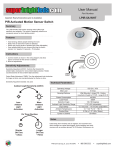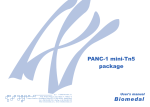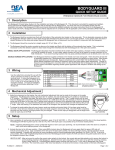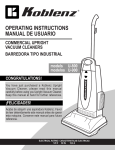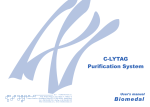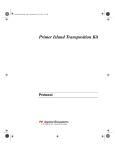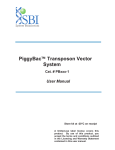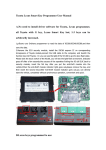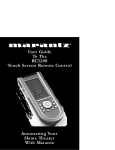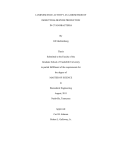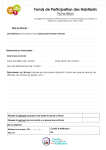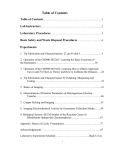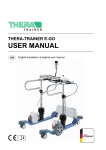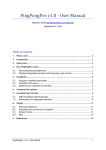Download pUT lacZ2.FH11
Transcript
PpUT lacZ2 vector Ed. 1 Web: www.biomedal.com . © 2006 Biomedal, S.L. Email: [email protected] User's manual Biomedal NOTES pUT lacZ2 vector Delivery System pUTmini-Tn5 vector carrying a minitransposon containing a lacZ gene to generate transcripcional/translational fusions. For research use only 1. Product Description ....................................................2 1.1. pUTlacZ2 vector ..............................................2 1.2. pUTmini-Tn5 vectors features ................................3 pUT lacZ2 Vector Contents 2. General usages. Applications of pUT lacZ2 ..................4 3. Advantages of mini-Tn5 Vectors vs other chromosome integration systems .....................................................5 4. pUT lacZ2 Map ..............................................................5 16 5. Protocol ....................................................................6 5.1. Transformation of donor strain ................................6 5.2. Transfer of the DNA into the recipient strain.............7 5.3. Selection of exconjugants ...................................9 5.4. b-galactosidase assay ............................................10 6. Troubleshooting ........................................................11 7. Reagents and recipes .................................................12 8. References ................................................................13 9. Related products .......................................................14 10. Short protocol .........................................................15 www.biomedal.es 1 1. Product Description 10. Short Protocol. A. Transformation of donor strain. 1.1. pUT lacZ2 vector 2 Selection for resistance to Replication Origin Transfer Origin Antibiotic Resistance Host strain Copy number Kanamycin R6K RP4oriT Ampicillin, Kanamycin E. coli lpir strains Low PRODUCT QUANTITY STORAGE CAT. NO pUT lacZ2 8 mg 4ºC or -20ºC CV-3257 ! NOTE: The plasmid is supplied dried. www.biomedal.es B. Transfer of the DNA into the recipient strain (triparental mating). Filter system 1. Mix the 10-50 ml of overnight cultures of the donor, recipient and helper strains (1:1:1 mixtures of cultures overnight), in 5 ml of 10mM MgSO4, vortex for a few seconds, transfer to a 5 ml disposable syringe, and filter through a Millipore membrane (or equivalent). 2. Remove carefully the drained membrane on the agar surface of an LB plate (cell side up), avoiding bubbles formation. 3. Incubate the plates at 30-37 ºC for 8-18 hours. Drop system 1. Mix the 10-50 ml of overnight cultures of the donor, recipient and helper strains (1:1:1 mixtures of cultures overnight), centrifuge the mixture and discard the supernatant. Resuspend the pellet in 20 ml of LB medium and place on a LB plate. Let to dry the drop on the plate. 2. Incubate the plates at 30-37 ºC for 8-18 hours. C. Selection of exconjungants. 1.To filter system: Resuspend the filter with the mating mix in 5 ml of 10 mM MgSO4 . To drop system: Recover the mating mix on the plate and resuspend in 5ml of 10 mM MgSO4 . 2. Plate 100-500 ml of this suspension on selective LB agar medium containing tetracycline. 3. Incubate the plates at the optimal growth temperature of the recipient strain until colonies become visible. 4.Confirm that the acquisition of the selected phenotype is due to an authentic transposition event and not to integration of the delivery plasmid in a recipient replicon or its illegitimate replication in the new host, by Southern blot, PCR analysis or growing the exconjugants onto medium containing b-lactam antibiotic. pUT lacZ2 Vector pUT lacZ2 is a 10.4 Kb plasmid, that is included in the collection of pUTmini-Tn5 derived vectors. This vector contains the minitransposon miniTn5lacZ2 cloned in the pUT backbone. Mini-Tn5lacZ2 carries a lacZ sequence, downstream of the Tn5 I end of the transposon. Since the termini have neither transcriptional terminators nor stop codons in several of the possible frames, this vector is designed for generation of type II (transcriptional/translational) lacZ fusions (1). Mini-Tn5 lacZ2 creates carboxy-terminal gene fusions with the interrupted chromosomal gene and lacZ when inserted in the proper reading frame. These fusions begin with an lacZ moiety at codon 9, which is separated from the interrupted gene by a 49 base pair linker sequence composed of the 19 base pair I end of Tn5 and an additional 30 base pairs (2). The minitransposon also carries as a selection marker a gene that confers kanamycin resistance, upstream of O termini. 1. Transform S17-1 lpir or DH5a lpir cells with pUTlacZ2. 2. Select the transformants by plating onto LB /ampicillin (100 mg/ml)/ kanamycin (25 mg/ml) plates. Incubate at 37ºC overnight. 15 9. Related Products. PRODUCT STRAINS VECTORS 14 Cat. No. E. coli DH5a lpir Propagation of pUT plasmids BS-3233 E. coli CC118 lpir Propagation of pUT plasmids BS-3235 E. coli S17-1 lpir Propagation of pUT plasmids BS-3234 E. coli DH5a (pRK2013) Mating helper strain BS-3236 E. coli DH5a (pRK2073) Mating helper strain BS-3263 pUToriR6K Amplification by PCR (selection of positive clones) and sequencing of cloned fragments PR-3280 pUT mini-Tn5 Cm Mini-transposons derivates vectors (repeat insertion events) CV-3223 pUT mini-Tn5 Km Mini-transposons derivatives vectors (repeat insertion events) CV-3224 pUT mini-Tn5 Sm/Sp Mini-transposons derivatives vectors (repeat insertion events) CV-3225 pUT mini-Tn5 Tc Mini-transposons derivatives vectors (repeat insertion events) CV-3226 pUT mini-Tn5 Tel Mini-transposons derivatives vectors (repeat insertion events) CV-3227 pUT/lacZ1 Mini-transposons derivatives vectors with a reporter gene CV-3256 pUT/lacZ2 Mini-transposons derivatives vectors with a reporter gene CV-3257 pUT/phoA Mini-transposons derivatives vectors with a reporter gene CV-3258 pUT/luxAB Mini-transposons derivatives vectors with a reporter gene CV-3259 Auxiliary plasmid for cloning Auxiliary plasmid for cloning Test culture Test culture Test culture Test culture Test culture CV-3282 CV-3248 RS-3217 RS-3218 RS-3219 RS-3221 RS-3220 pUC18Not pUC18NotSfi Apicillin Chloramphenicol ANTIBIOTICS Kanamycin Streptomycin Tetracycline REAGENTS and SOLUTIONS DESCRIPTION Potassium Tellurite Selection of transformants RS-3222 TSS Competent cells preparation RS-3215/ RS-3216 www.biomedal.es All pUTmini-Tn5 plasmids carry a common backbone (pUT backbone) and a variable mobile element (mini-Tn5). The mobile element (mini-Tn5 elements) consists of an Sfi I cassette containing a selection marker and a single Not I site outside of the cassette that can be used for cloning foreign DNA fragments. Flanking these two features are the 19 base pair I and O termini of Tn5 transposon. In this vectors any heterologous DNA segment can be cloned within the boundaries of a mini-Tn5 element and finally inserted into the chromosome of Gram negative bacteria target (3). The backbone pUT includes the R6K origin of replication sequence, the RP4oriT origin of transfer sequence, the bla gene sequence (ampicillin resistance) and the tnp* gene sequence. The tnp* is a mutant tnp gene of IS50R (Tn5 transposon), and encodes for the transposase needed for transposition of the mini-Tn5 elements. tnp* carries a single mismatch that changed the GCG codon specifying Ala-168 of the tnp gene to the Ala codon GCC. This change eliminate the Not I site without changing the structure of the tnp product (4). The tnp* gene is presented in cis but external to the mobile element. Due to the loss of the tnp* gene after insertion, minitransposons are stably inherited and do not cause DNA rearrangements or others forms of genetic instability. Plasmids having the R6K origin of replication require the R6K-specified replication protein p and can be maintained only in host strains producing this protein (lpir strain). It also carry the origin of transfer oriT of plasmid RP4, which results in efficient conjugal transfer to recipient strain from donor strains expressing RP4-conjugative functions (5). Delivery plasmids are thus mantained stably in lpir lysogens or in E. coli strains with the pir gene recombined in their chromosome, and can be mobilised into target strain cells through RP4 transfer functions. Delivery of the donor plasmids into selected host bacteria is accomplished through mating with the target strain. pUT lacZ2 Vector PRIMERS 1.2. pUT mini-Tn5 vectors features. 3 2. General usages. Applications of pUT/lacZ2. Mini-transposons derivative vectors provide a straightforward tool to clone and insert foreign genes stably into the chromosomes of a variety of Gram negative bacteria such E. coli, Klebsiella, Salmonella, Brucella, Proteus, Vibrio, Bortedella, Actinobacillus, Rhizobium, Acinetobacter, Rhodobacter, Agrobacterium, Alcaligenes and several Pseudomonads (1). This vector also simplifies the generation of insertion mutants (insertion mutagenesis), in vivo fusions with reporter genes (promoter probing) and analysis of transcriptional terminators. 4 One important feature of mini-Tn5 elements is that, as a result of the loss of the transposase-cognate inhibitor along the pUT system after transposition (transposase function is not maintained in target cells), a single recipient strain can be used for repeated insertion events with differentially marked minitransposons. Multiple insertions in the same strain are therefore only limited by the availability of distinct selection markers. pUT lacZ2 is included into mini-Tn5 derivatives vectors that have been adapted for promoter probing, by means of generation of type II gene fusions (transcriptional/translational) with target genes. This vectors do not have transcriptional terminators within the I and O terminal sequences of Tn5, and the insertion of the minitransposon in the appropriate orientation downstream of chromosomal promoters may active the expression of a promoterless gene placed within the mobile unit (1). pUT lacZ2 is a vector designed to generate random gene fusions, with lacZ as reporter gene. www.biomedal.es Ampicillin 100 mg/ml stock solution Dissolve 1 g ampicillin in 9 ml of deionised water. Add deionised water to a 10 ml volume final. Filter sterilize the solution with a 0.22 m filter. Store the stock solution at 20ºC. Biomedal Cat. No. RS-3217 Kanamycin 25 mg/ml stock solution Dissolve 0.25 g of kanamycin in 9 ml of deionized water. Bring up to a 10 ml final volume with water deionized. Filter sterilize the solution with a 0.22 m filter. Store the stock solution at 4ºC. pUT lacZ2 Vector Mini-Tn5 vectors are used in the analysis, construction and manipulation of complex phenotypes in a wide range of Gram negative bacteria. The main virtue of these cloning vectors is their ease for insertion of one or more segments of heterologous DNA in the chromosome of the strain of interest, by means of a mating between a donor strain and a recipient strain. As cloning vectors, are useful to stably maintain a recombinant phenotype in the recipient strain. 4. ANTIBIOTICS AND ADDITIVES Biomedal Cat. No. RS-3219 8. References. 1. De Lorenzo V., Timmis K.N. 1994. Analysis and Construction of Stables Phenotypes in Gram-Negative Bacteria with Tn5- and Tn10-Derived Minitransposons. Methods in Enzimology, 235, p. 386-405. 2. De Lorenzo V., Herrero M., Jakubzik U., Timmis K.N. 1990. Mini-Tn5 transposon Derivatives for Insertion Mutagenesis, Promoter probing and Chromosomal Insertion of Cloned DNA in Gram-Negative Eubacteria. Journal of Bacteriology, 172, p. 6568-6572. 3. De Lorenzo V., Timmis K.N. 1994. Analysis and Construction of Stables Phenotypes in Gram-Negative Bacteria with Tn5- and Tn10-Derived Minitransposons. Methods in Enzimology, 235, p. 386-405. 4. Herrero M., De Lorenzo V., Timmis K.N. 1990. Transposon vectors Containing Non-Antibiotic Resistance Selection Markers for Cloning and Stable Chromosomal Insertion of Foreign Genes in Gram-Negative Bacteria. Journal Bacteriology, 172, p.6557-6567. 5. De Lorenzo V., Herrero M., Sánchez J., Timmis K.N. 1998. Minitransposons in microbial ecology and environmental biotechnology. FEMS Microbiology Ecology, 27, p. 211-224. 6. Boyd D., Weiss D.S., Chen J.C., Beckwith J. 2000. Towards single-Copy gene expression systems making gene cloning physiologically relevant: Lamda Inch, a simple Escherichia coli plasmid-chromosome shuttle system. Journal Bacteriology, 182, p. 842-847. 13 7. Reagent and Receipes. 1. MEDIA LB (per liter) (liquid) Dissolve in 950 ml of deionised water. Adjust pH to 7.0 with 5 N NaOH. Add deionised water to 1 l final volume. Autoclave and let cool to below 55ºC. LB agar (plates) Exactly like liquid LB but adding 15 g agar after adjust the pH. Ease for insertion of one or more segments of the heterologous DNA in the chromosome of the strain of interest (any heterologous DNA segments can be inserted into the chromosome of target cells after a few simple genetic manipulations). § Conditional replication to allow selection for integration into the chromosome (suicide plasmids). The mini-Tn5 would be able to transpose from the plasmid to the chromosome but when succesive cell divisions occur, the plasmid vector would be lost to the population. § § pUT lacZ2 Vector · 10 g tryptone · 5 g yeast extract · 10 g NaCl 3. Advantages of mini-Tn5 Vectors vs other chromosome integration system. Insert foreign DNA stably into the chromosomes. Wide range of inserted fragments size. pUTmini-Tn5 plasmids allow the cloning of variable size fragments. Heterologous DNA of 12 Kb cloned in miniTn5 derivatives are transposed at frequencies in the range of those observed with insert-lacking transposon (1). In other system the range of sizes is more restricted. For example, lambda Inch vectors system allow to insert fragments a total of about 7 Kb (6). § 2. MATING SOLUTION 12 Magnesium phosphate (MgSO4 7H2O) 1M solution Dissolve 24.6 g of MgSO 4 7H 2 O in 100 ml of deionised water. Autoclave sterilize. 3. b-GALACTOSIDASE ASSAY REAGENTS Z-Buffer · 16.1 g Na2HPO47H2O · 5.5 g NaH2PO4H2O · 0.75 g KCl · 0.246 g MgSO47H2O Dissolve in 950 ml of deionised water. Adjust pH to 7.0. Add deionised water to 1 l final volume. Do not autoclave. Store at 20°C in 50 ml aliquots. Add 135 ml of b-mercaptoethanol/50 ml Z-buffer, before use it. ONPG Dissolve 0.8 g ONPG in 200 ml of Z-buffer. Store at 20°C in 10 ml aliquots. www.biomedal.es § Inserted DNA segments remain stably inherited and produce no burden to the carrier strain. Posibility of multiple insertions in the same strains (only limited by the available selection markers), as a result of the loss of the transposase function, which is not maintained in target cells. Easy modification of the cloning vector, because of the modular nature of the constructions. § Use of cleavage sites of the rare cutters Not I and Sfi I (for cloning convenience the vector has an array of unique cloning sites). § § The pUTmini-Tn5 plasmids are transferable to a variety of bacteria. 5 4. pUT lacZ2 map. BamHI SmaI EcoRI SfiI 6. Troubleshooting HinDIII XhoI SfiI ClaI SmaI HinDIII NotI ClaI NotI PROBLEM Loss of pUT plasmids. O I Km HinDIII BamHI SalI PstI BamHI Zero or low frequency of RP4-mediated transfer. 5.2 kb bla PstI mobRP4 BamHI 5. Protocol. 5.1. Transformation of donor strain To insert mini-Tn5 lacZ2 into the chromosome of a recipient strain, first of all you must transform the donor strain with pUTlacZ2 vector. The protocol should be as follows. 1. Transform S17-1 lpir or DH5a lpir cells with pUTlacZ2. 2. Select the transformants by plating onto LB /ampicillin (100 mg/ml)/ kanamycin (25 mg/ml) plates. Incubate at 37ºC overnight. !NOTE:, You can use the TSS solution to perform the transformation (Biomedal, Cat. No. RS-3215, RS-3216). www.biomedal.es Selection conditions are inappropriate. pUT backbone BgIII SalI PstI BgIII PstI ScaI 6 Plasmid derivatives cannot Using of alternative donor strains. be maintained into delivery lpir strains EcoRI EcoRI HinDIII oriR6K tnp* HinDIII Low or zero yield of exconjugants. All exconjugants are resistant to ampicillin or others b-lactam antibiotics SOLUTIONS The exconjugant phenotype is not due to an authentic transposition events It is advisable to perform assay with the target cells before the matting/plating is carried out, because the minimal inhibitory concentration of the toxic compound used as marker can vary considerably among genera and strains. Properties of target cells such as restriction system, surface exclusion phenomena may lead to low frequency or zero transfer. If the target strain is unable to act as a recipient for RP4, the pUT plasmid cannot be introduced at high frecuency. Also, some changes in the mating protocol can be introduced. For example, avoid the pregrowth of the recipient strains on antibiotic medium prior to mating, since traces of the antibiotic present in the suspension or accumulated by the recipient cells can kill donor cells. Shorter times. Lower temperatures (30ºC). To E. coli recipient strains use LB medium with 0.5 M citrate to avoid the recipient strain infection by lpir phage. pUT lacZ2 Vector lacZ WHY? 11 5.4. b-galactosidase assay. pUT/lacZ2 carries lacZ gene as reporter. You can monitor expression levels by b-gal activity. 2. Mix 100 ml of sample, 900 ml of Z buffer, 2 drops of chloroform and 1 drop of 0.1% SDS. 3. Vortex the tubes for 10 seconds. 4. Equilibrate samples to room temperature for 15 minutes to evaporate the chloroform. 5. Add 200 ml of ONPG (in Z buffer) to each tube. 6. After a yellow color develops, stop the reaction by adding 500 ml of 1 M of Na2CO3 1 M solution to each tube, following the same timed addition order. Record, in minutes, the incubation time. 10 To transfer the minitransposon into the recipient strain, the genes that code for mobilisation and chromosomal transfer (tra and mob genes), are necessary. These genes can be present in a host strain or can be provided by way of a helper plasmid. When employing host strains such as E. coli SM10 lpir or E. coli S17-1 lpir, the transformed transposon DNA is transfered via biparental mating. The transfer can also be achieved by triparental mating mediated by a helper plasmid. In the triparental mating the conjugatable suicide minitransposon donor is introduced into the recipient strain by a helper plasmid, which self mobilises from its own host into the donor strain and provides the genes necessary for the conjugal transfer of the miniTn5 from the donor host strain to the recipient, provided the vector plasmids contain the specific recognition site for mobilisation. Since some lpir RP4 strains like E. coli SM10 lpir or E. coli S17-1 lpir, cannot stably maintain the pUT plasmids, we recommend other strains to propagate this vectors without problems, such as DH5a lpir. To mobilize the delivery plasmid directly from the donor strain into target cells in this case, a triparental mating with a helper strain such as E. coli DH5a (pRK2013) or E. coli DH5a (pRK2073) is necessary. !NOTE: 7. Read the absorbance of the samples at OD420. 8. Determine the Miller units of expression by means of the formula: 7 To propagate pUTmini-Tn5 in lpir strains, you can use the TSS solution to perform the transformation (Biomedal, Cat. No. RS-3215, RS-3216). Triparental mating (OD420 ) x (1000) Miller units=------------------------------- x 1000 (tmin) x (OD600 ) x (dilution) 1. Grow overnight cultures in LB of each of the three strains: donor strain, recipient strain and helper strain: Inoculate a single colony of donor strain DH5a lpir carrying the desired pUT vector or derivative plasmid in LB medium containing 100 mg/ml ampicillin and 25 mg/ml of kanamicyn (the adequate concentration to ensure maintenance of the delivery plasmid). Incubate with shaking at 37ºC overnight. Grow the recipient strain: Inoculate a single colony under the same conditions (at different temperature, if necessary), but preferably without selection (see Troubleshooting). Inoculate a single colony of E. coli DH5a (pRK2073) in LB medium, preferably without selection. n n n www.biomedal.es pUT lacZ2 Vector 1. Take 1 ml pellet from induced and uninduced expression culturers, with a known OD600. Resuspend the pellet in 1 ml of Z buffer. 5.2. Transfer of the DNA into the recipient strain 2. Mix the 10-50 ml (~108 cells) of overnight cultures of each of the three strains (1:1:1 mixtures of cultures overnight), in 5 ml of 10mM MgSO4 , vortex for a few seconds, transfer to a 5 ml disponsable syringe, and filter through a Millipore membrane, 13-25 mm diameter type HA (0.45 mm) or equivalent, placed on a reusable filter case. ! IMPORTANT!: Alternatively, mix the 10-50 ml of overnight cultures of helper strain, donor strain and recipient strain, centrifuge the mix and discard the supernatant. Resuspend the pellet in 20 ml of LB medium or 10 mM MgSO4 using vortex and place it on LB plate, without dispersing it. Let it dry. Go to step 4. ! NOTE: When you use the filter system, if too many donor, recipient or helper cells are used and the membrane clogs, it is better to refilter a more diluted mix. If you need only few insertions, 10 ml drops of cultures of donor, recipient and helper strains can be mixed and spotted on an LB plate, which is then dried and incubated for several hours before the mating mixture is streaked out on selective medium (go to step 4). 8 3. After the filtering, remove carefully the drained membrane on the agar surface of an LB plate (cell side up). You can help yourself with sterile tweezers, preferably with curved tips. ! NOTE: You can use alternative culture medium instead of LB, to favour recipient strain viability. Air bubbles should be avoided between the filter and agar surface. 4. Incubate the plates at 30-37 ºC for 8-18 hours. !NOTE: Several alternatives to mating protocol are possible, according to individuals needs. Strains ratios (donor/recipient/helper), temperatures, time of mating and culture medium can be changed to suit specific requeriments of the recipients. Biparental mating If you use E. coli SM10 lpir or E. coli SM17-1 lpir as donor strains, to set up the biparental mating, you must follow the same protocol as when using triparental mating, but without helper strain. You must mix equal volumes (1050 ml) of overnight cultures of the donor and recipient strain, in 5 ml of 10 mM MgSO4, and proceed as described above. www.biomedal.es The selection of clones with the minitransposon inserted in the chromosome is a critical step. The procedure is as follows. 1.If you use filter system: Resuspend the filter with the mating mix in 5 ml of 10 mM MgSO4. If you use drop system: Recover the matting mix on the plate using a sterile inoculating loop and resuspend in 5 ml of 10 mM MgSO4. !NOTE: This suspension can be kept at 4ºC for several weeks. 2. Plate 100-500 ml of this suspension on selective LB agar medium with kanamycin. The kanamycin concentration must be adequate to ensure maintenance of the delivery plasmid, but you must determine the minimal inhibitory concentration of antibiotic. !NOTE: pUT lacZ2 Vector NOTE: pRK2073 plasmid confers streptomycin/spectinomycin resistance. To remove antibiotics from donor strain culture, an additional washing step is necessary. 5.3. Selection of exconjugants When the marker carried by the minitransposon is an antibiotic resistance determinant, optimal concentrations of antibiotics to the selection can vary among strains. The minimal inhibitory concentration (MIC) must be determined in each case. The concentrations in the table below can be used as a guideline. ANTIBIOTIC Chloramphenicol Kanamycin Streptomycin Spectinomycin Tetracycline ORIENTATIVE MIC 5-50 mg/ml 25-75 mg/ml 50-100 mg/ml 50-100 mg/ml 2.5-15 mg/ml 3. Incubate the plates at the optimal growth temperature of the recipient strain until colonies become visible. 4.Confirm that the acquisition of the selected phenotype is due to an authentic transposition event and not to integration of the delivery plasmid in a recipient replicon or its illegitimate replication in the new host. The insertion can be confirmed by Southern blot or PCR analysis. Another procedure consist of growing the exconjugants on medium containing b-lactam antibiotic, because authentic transposition results in the loss of the portion of the delivery plasmid containing bla gene and the exconjugants will be sensitive to ampicillin and other b-lactams (see Troubleshooting). 9









